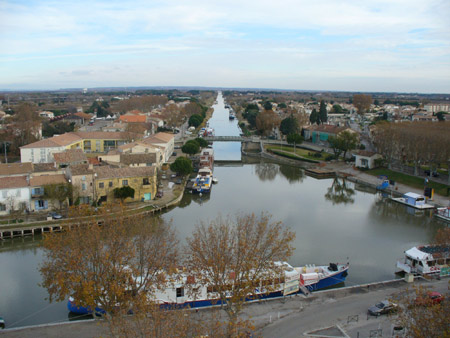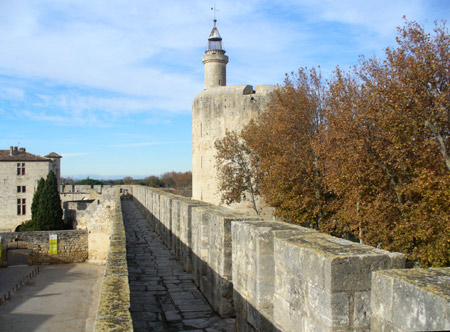 Aigues-Mortes was founded as a port in 1246 by Louis IX, who used it as his base for two Crusades in 1248 to Cyprus and in 1270 to Tunis (where he met with his death). His son, Philip, took over from his father and commissioned Genoan engineers to build up Aigues-Mortes' famous fortified walls and grid-pattern streets.
Aigues-Mortes was founded as a port in 1246 by Louis IX, who used it as his base for two Crusades in 1248 to Cyprus and in 1270 to Tunis (where he met with his death). His son, Philip, took over from his father and commissioned Genoan engineers to build up Aigues-Mortes' famous fortified walls and grid-pattern streets.
For a time the town prospered from the nearby salt beds and from the handling of goods such as spices and wool which came into the port. But when Provence became part of France in 1481, Marseille took its place as the major port of southern France.
 Our first view of the town was of the Tower of Constance, an impressive round tower adjoining the ramparts, which is well-known in the region for its bitter role in the suppression of Protestantism in the seventeenth century, when it was used to imprison 15 - 80 Huguenots, mostly women. The most famous of these was Marie Durand who lived 38 years in the tower (1730 – 1768) and who is purported to have scratched the words “resister” on a castle wall.
Our first view of the town was of the Tower of Constance, an impressive round tower adjoining the ramparts, which is well-known in the region for its bitter role in the suppression of Protestantism in the seventeenth century, when it was used to imprison 15 - 80 Huguenots, mostly women. The most famous of these was Marie Durand who lived 38 years in the tower (1730 – 1768) and who is purported to have scratched the words “resister” on a castle wall.
 We docked there overnight and the next morning we entered the fortress through the main gate.
We docked there overnight and the next morning we entered the fortress through the main gate.
 We walked around inside the fortress...
We walked around inside the fortress...
 ...and out through another gate...
...and out through another gate...
 ..to see the walls from the other side.
..to see the walls from the other side.



 On our way to the Tower of Constance, we saw this memorial to the Huguenots. These French Protestants were first protected by the Edict of Nantes in 1598 by Henry IV of France. This edict was revoked in 1685 by Louis XIV and the Protestants were persecuted or forced to leave the country. This edict decreed that men who are caught and arrested while trying to flee would be killed or condemned to the galleys for life. Therefore this memorial displays the Huguenot Cross (upper left), a matrix representing prison cells (lower left) and a ship propelled by galley slaves.
On our way to the Tower of Constance, we saw this memorial to the Huguenots. These French Protestants were first protected by the Edict of Nantes in 1598 by Henry IV of France. This edict was revoked in 1685 by Louis XIV and the Protestants were persecuted or forced to leave the country. This edict decreed that men who are caught and arrested while trying to flee would be killed or condemned to the galleys for life. Therefore this memorial displays the Huguenot Cross (upper left), a matrix representing prison cells (lower left) and a ship propelled by galley slaves.


 From the tower we could see the canal where our barge was docked, just beyond the bridge in the distance.
From the tower we could see the canal where our barge was docked, just beyond the bridge in the distance.
 In another direction, we could look over the walls and see piles of salt produced from the sea water.
In another direction, we could look over the walls and see piles of salt produced from the sea water.
 A telephoto shot of the salt.
A telephoto shot of the salt.
 Elizabeth and I had time to walk around the walls, about a mile walk.
Elizabeth and I had time to walk around the walls, about a mile walk.
 It was interesting to see the various towers from this elevation.
It was interesting to see the various towers from this elevation.


We sailed in the afternoon to Carnon, where we would dock for the night. Some of the group rode bikes into the town, while others stayed on the barge or played petanque on the shore.
 We were treated to a beautiful sunset that evening.
We were treated to a beautiful sunset that evening.
Tomorrow we will sail to Sete.
